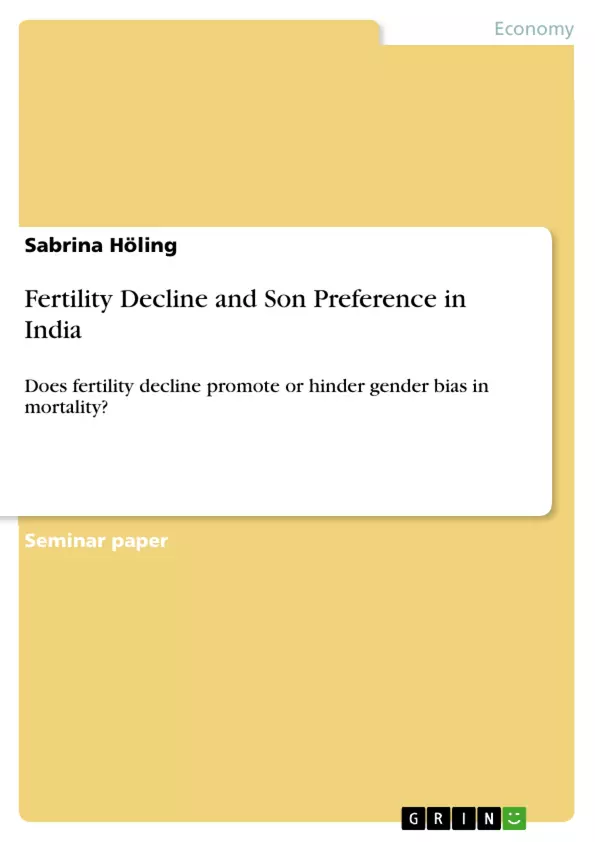In the backdrop of the debate on missing women and son preference in Asia, this paper deals with the influence of fertility decline in India on gender bias in mortality. In order to get more precise answers, the text concentrates on gender bias in prenatal mortality and infant mortality. I will test two contradicting hypotheses empirically using among others data from three rounds of the National Family Health Survey in India (1992, 1998 and 2005). These constitute the foundation for further studies in order to answer the question whether fertility decline promotes or hinders gender bias in mortality. Judging the relation of these two variables by female education will show the strong link between female education and fertility. I will find out that son preference in India stays constant, independent from the mother´s educational level. Nonetheless, this text will show that the level of female education determines how parents interfere with their child´s sex. Empirical data will prove that higher educated women prefer prenatal technology for girl elimination while uneducated women have less access to or knowledge of it. The data will also suggest that less educated mothers have a higher daughter infanticide rate. I will conclude that fertility decline intensifies gender bias in prenatal mortality. However, the influence it might have on female infant mortality can not be estimated correctly because of incomplete empirical data.
Inhaltsverzeichnis (Table of Contents)
- List of abbreviations
- Introduction
- Fertility
- Definition of Fertility
- Fertility Decline in India
- Gender bias and Mortality
- Origin of and Reasons for Gender Bias
- Data of Gender Bias
- Pre-natal Gender Bias: Abortion in India
- Post-natal Gender Bias: Gender Bias in Child Mortality
- Contradicting Hypotheses
- Hypotheses 1: Fertility Decline hinders Gender Bias in Mortality
- Hypotheses 2: Fertility Decline promotes Gender Bias in Mortality
- Empirical Evidence to the Hypotheses: Fertility Decline intensifies Gender Bias in Mortality
- Conclusion
- References
- Internet Recources
- Monographs and Working Papers
- List of Figures
- List of Tables
Zielsetzung und Themenschwerpunkte (Objectives and Key Themes)
This paper examines the relationship between fertility decline and gender bias in mortality in India, specifically focusing on pre-natal and infant mortality. The objective is to determine whether fertility decline exacerbates or alleviates gender bias in mortality rates. The paper explores this complex relationship through two contrasting hypotheses, drawing on data from the National Family Health Survey in India.
- The impact of fertility decline on gender bias in mortality in India
- The role of female education in influencing fertility and gender bias in mortality
- The prevalence of son preference in India and its influence on pre-natal and infant mortality
- The use of pre-natal technology for gender selection in India
- The implications of missing women for India's future
Zusammenfassung der Kapitel (Chapter Summaries)
The paper begins by defining fertility and discussing its decline in India. It then explores the origins and reasons for gender bias in mortality, focusing on the data available and the specific issues of pre-natal and post-natal gender bias. The paper presents two contrasting hypotheses: 1) that fertility decline hinders gender bias in mortality and 2) that fertility decline promotes gender bias in mortality. It then delves into the empirical evidence, exploring the relationship between fertility decline and gender bias in pre-natal mortality, and discusses the limitations in assessing the impact on infant mortality.
Schlüsselwörter (Keywords)
This paper explores the connection between fertility decline and gender bias in mortality in India, specifically focusing on pre-natal and infant mortality. Key concepts include female education, son preference, pre-natal technology for gender selection, and the National Family Health Survey (NFHS) data.
- Arbeit zitieren
- Sabrina Höling (Autor:in), 2011, Fertility Decline and Son Preference in India, München, GRIN Verlag, https://www.grin.com/document/184321



